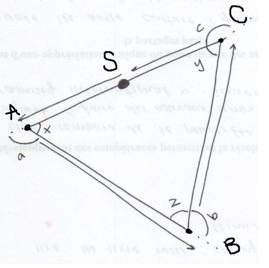Or search by topic
Number and algebra
Geometry and measure
Probability and statistics
Working mathematically
Advanced mathematics
For younger learners
Walking Round a Triangle



- Problem
- Getting Started
- Student Solutions
- Teachers' Resources
The questions asked were:
How much was turned?
Is it always the same and (the big question) - why?
There was a lot of confusion about the angles involved and most solutions that were sent in indicated $180$ degrees. This number of degrees is of course involved in what we know of triangles. However, when going around a triangle we do not turn the internal angle but $180$ minus the internal angle.
The solution sent in by a pupil from TNT school in Canada does quite well in showing this.
The triangle on which the ladybird walks has three arbitrary angles x, y, and z whose sum is $180$ degrees. The ladybird starts at S facing point A. Once it reaches A it turns an angle "a" and now faces point B. It does the same at point B and C (turning an angle "b" and face C;
turn an angle "c" and face A respectively). The sums of angles a and x, c and y, b and z are each $180$ degrees. By adding: $(a+x) + (y+c) + (z+b) =$ $540$ degrees and subtracting x,y and $z = 360$ degrees so the ladybird turns $360$ degrees.

This would be the same for any triangle because this is a triangle with unspecified angles.
The other solution that tried to answer all the three questions was from Alexis who goes to Claremont Fan Court School, who goes on to say;
The Ladybird turns $360$ degrees in total. This is because in order to get back to the direction you were facing, you have to turn around $360$ degrees however many facings you go around. Ergo, this is true for any triangle, or any regular polygon for that matter.
Well done the two of you.
You may also like
Let's Investigate Triangles
Vincent and Tara are making triangles with the class construction set. They have a pile of strips of different lengths. How many different triangles can they make?

